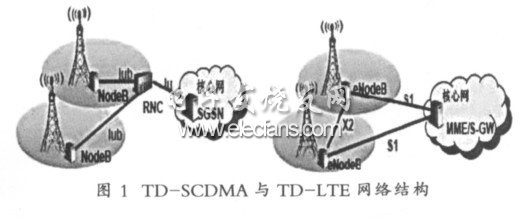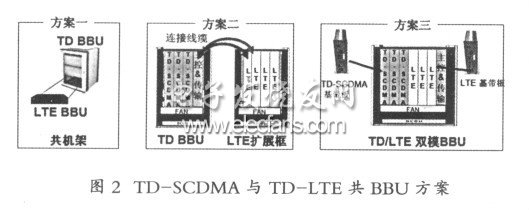TD-SCDMA technology has now begun to be applied on a large scale. TD-LTE is the follow-up evolution technology of TD-SCDMA, and commercial products will mature quickly. Therefore, it is necessary to promote TD-SCDMA equipment support and TD-LTE co-platform capabilities as soon as possible to protect network equipment investment costs as much as possible. In addition, TD-LTE may coexist with the TD-SCDMA network for a long period of time. During this period, the contradiction between the site and the sky resources will become increasingly prominent, and resource sharing is urgently needed, which also puts forward an urgent need for a network equipment sharing platform. .
1 Common platform involves network element and device type analysis
At present, RNC + NodeB is used in TD-SCDMA to form the wireless side network. In the future, TD-LTE will adopt a flat structure, and there will no longer be independent RNC network elements. The corresponding functions will be implemented by eNodeB. In addition, the distributed base station type of BBU + RRU is widely used in TD-SCDMA, while the distributed and integrated macro base station type may be used in TD-LTE. Due to the differences in device types, it is difficult to share TD-LTE integrated common macro stations with TD-SCDMA distributed base stations. Therefore, we will focus on the common platform solution for BBU + RRU distributed station NodeB devices.

2 TD-LTE and TD-SCDMA common platform feasibility plan
2.1 Total BBU feasibility plan
In the future broadband system, due to the sharp increase in the amount of baseband data processing, the cost share of the baseband part in the base station will become higher and higher. The devices used in the design of the base station are generally software programmable devices, which provides an innate advantage for the two systems to share the hardware platform. According to different levels of sharing, there are three common BBU solutions: common rack, cascading common, and dual-mode BBU, as shown in Figure 2 and Table 1, respectively.
Table 1 TD-SCDMA and TD-LTE common BBU scheme analysis


TD-LTE and TD-SCDMA share a BBU, which requires comprehensive consideration of cost savings and the difficulty of designing existing equipment. For TD-SCDMA cabinet-type BBUs whose hardware processing capabilities meet the requirements, during the TD-SCDMA deployment phase, the corresponding slots can be reserved for future TD-LTE baseband boards, and the backplane must also have the corresponding data exchange bandwidth capabilities To support the common platform of TD-SCDMA and TD-LTE. In addition, in order to reduce the requirements on the backplane capability of existing TD-SCDMA base stations, TD-LTE is required to perform baseband processing of at least one typical sector on a single baseband board (2 & TImes; 2MIMO, 20MHz bandwidth) to avoid excessive Backplane data exchange process.
2.2 Total RRU feasible solutions
Whether TD-SCDMA and TD-LTE can share RRU is mainly considered from the following aspects:
(1) Bandwidth requirement: limited by the bandwidth of ADC / DAC in DPD, the current power amplifier module generally supports up to 30MHz, so the total PA requires TD and LTE to work in the adjacent frequency band not exceeding 30MHz, ie LTE (20MHz) + TD (10MHz);
(2) Signal peak-to-average ratio requirements: TD and LTE are both peak-to-average ratio (PAR) systems. After sharing, the signal PAR will further increase, which puts forward higher requirements on the linearity of the power amplifier;
(3) Power requirements: If LTE also uses the 8-channel smart antenna mode, according to the theoretical calculation of the current 20W power output requirements in LTE, the total output power of each channel is required to reach about 8W after a total of PA to meet both TD-SCDMA and TD- LTE requirements, which pose a certain challenge to the RRU thermal design. Front-end filters and LNA can generally achieve hundreds of MHz bandwidth, and can fully achieve cross-band sharing;
(4) Digital IF processing device: Due to the different baseband rates of TD and LTE, ASIC chips based on existing TD systems cannot be shared.
If the digital intermediate frequency is implemented by FPGA, it can be fully used without too much technical difficulty.
From the above analysis, it can be seen that when TD and LTE work in the same frequency band, they can share the same RRU transceiver channel, but because they share the same transceiver switch, it is required that the TD-LTE and TD-SCDMA time slot conversion points are consistent, which When the two systems do not need additional frequency separation, they can meet the system coexistence interference requirements. The RRU structure is shown in Figure 3.

When TD-SCDMA and TD-LTE work in different frequency bands, for example, TD-SCDMA and TD-LTE work in B and C bands, respectively, the two systems are separated by a bandwidth of about 300MHz, which is limited by the current device support capabilities (mainly in RRU Devices such as PA only support a maximum bandwidth of 30MHz), so RRU sharing cannot be achieved. When TD and TD-LTE share an antenna, an external adapter is required to connect the RRU.

Led Addressable pixel Screen is a simple, powerful and perfect flexible screen.
It can not only play like a traditional Led Pixel Screen,run animations, run effects, but also follow you anywhere, anytime, anywhere you want to show it. Everyone's effect.The utility model has the advantages of small volume,light weight, arbitrary bending and convenient carrying. Suitable for hotels, nightclubs, KTV and other places decorative to the city to achieve beauty / lighting effects
Can be produced according to customer requirements, support customized.
Flexible LED Screen,LED Pixel Screen,LED Display Screen,LED Panel Screen
SHEN ZHEN SEL LIGHTING CO.,LTD , https://www.sel-lighting.com